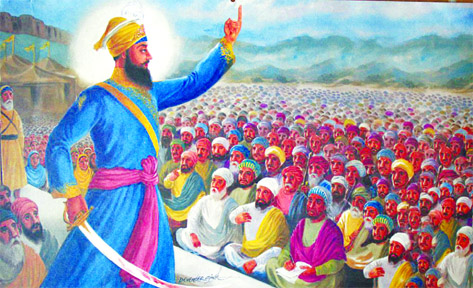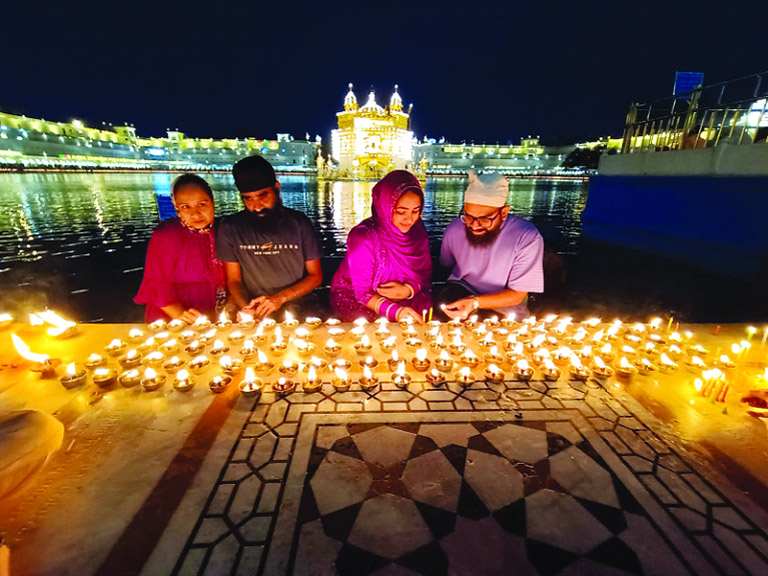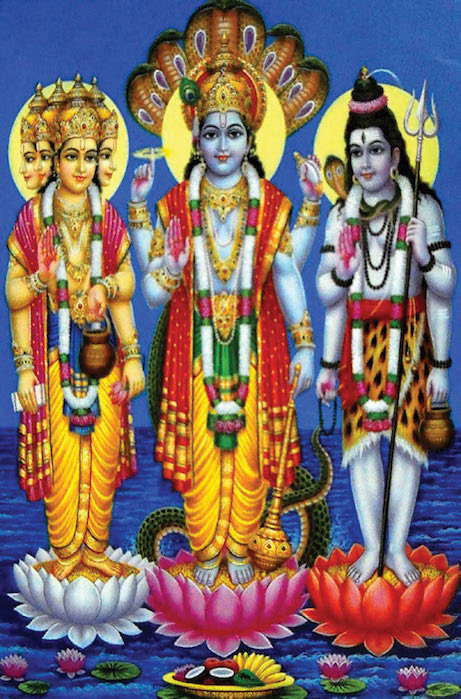
Khalsa, the purified and reconstituted Sikh community, instituted by Guru Gobind Singh on March 30, 1699 (Vaisakhi Day). His declaration had three dimensions: it redefined the concept of authority within the Sikh community; it introduced a new initiation ceremony and code of conduct; and it provided the community with a new religious and political vision. Khalsa is used to denote both the body of initiated Sikhs and the community of all Sikhs.
The early Sikh community had been shaped by three levels of authority: the masands (“Guru’s deputies”) were responsible for local congregations; the Guru was the active central authority; and the revealed word as recorded in Sikh scriptural text served as the symbolic base. With the establishment of the Khalsa, the authority of the masands was eliminated. They were expected either to become members of the community on a par with all others or to leave the fold.
Gobind Singh also introduced a new initation rite. More commonly called amrit pahul (“the nectar ceremony”) but also known as khande ki pahul (literally, “ceremony of the double-edged sword”), it was centred on a belief in the transformative power of the revealed word. The word was recited while water for initiation was stirred with a double-edged sword. Every Sikh who underwent the ceremony became a member of the Khalsa, was assigned the name Singh (“Lion”), and was expected to observe a rigorous code of conduct (rahit) symbolized by the wearing of five items: kes (long hair), kangha (a comb), kachha (a pair of shorts), karha (a steel bracelet), and kirpan (a sword). The names of these items begin with the Punjabi letter k and thus came to be known as the five Ks. The Singhs were also expected to forswear tobacco, alcohol, and certain types of meat.
In its third aspect the Khalsa embodied a concrete political agenda: the pledge to realize the rule of the Sikh community (Khalsa Raj, “kingdom of God”) in the Punjab. These three interlocking dimensions have made the institution of the Khalsa perhaps the most powerful force in shaping Sikh identity during the past three centuries. Initially a male institution, it is now open to women (who take the name Kaur [“Princess]) as well, though Khalsa authority remains firmly in male hands.
The story of creation of Khalsa
It was the Baisakhi. The year was 1699. As usual, Sikhs from far and near had gathered together at Anandpur to celebrate the New Year Festival. However, the gathering was a bit different that day. This year Guru Gobind Rai had sent a message that every Sikh who could afford to come, must come to the annual fair. They should come to Anandpur with their hair and beard uncut; and that they should wear turbans instead of caps or scarves.
By noon, well over twenty thousand Sikhs (eighty thousand by one estimate) had assembled in the fair ground at Anandpur to participate int he festivals of the Baisakhi Day. Everybody was excited and looked forward to meeting the Guru as if tis unusual ‘message’ was especially sent for him. Also, there was a large and richly festooned tent pitched on a hillock overlooking the extensive fair grounds.
It was afternoon. Word went round that the Guru was in the marquee and he would be coming out soon to meet his Sikhs. All eyes were turned towards the tent and everyone was waiting patiently for Guru’s Darshan (appearance) and to receive his blessings. But it took a little longer than expected.
At last their patience was rewarded. Guru Gobind came out of the tend clad in a strangely coloured uniform. It was saffron coloured from top to toe with a blue waist band. There was a long sword hanging from his left side. He walked briskly and came to a specially erected platfrom near the tent. The skies were clear and bright; and the Guru seemed to be standing so near, although he was actually at some distance from the people in the back. He had a strange smile on his face. Suddenly he stopped staring at the crowd, he pulled his sword out and raised it high with his right hand. There were a million voices and then a sudden hush.
Now, like a thunder, the Guru spoke, “My dear Sikhs, I am glad to see so many of you here today. Today I have planned to offer you something special. but for this I need your help. Indeed, I need your head. I need the head of a Sikh who claims his faith in me.”
There was a deadly silence all around. Everybody was too stunned to walk away or even whisper. Then the Guru flashed his sword again, raised his voice and repeated, “My Sikhs, I want a head and nothing less than a head. If anyone among you claims to be a true Sikh, then come forward and prove it.” He looked so fierce and blood thirsty.
Before he had finished his last sentence, a tall lean Sikh was already moving forward towards the Guru on the platform. His name waas Daya Ram and he was from Lahore. Reaching the Guru, he folded his hands, bent his head forward and said, “O, Lord, the true Guru, I claim to be your humble Sikh. My head is ready for you. Please take it.”
Hurriedly, the Guru held him by the arm and led him into the tent. Soon after the crowd inside heard the sound of a sword striking a body. They then heard a voice, Waheguru and then a loud thud. Then they saw the Guru coming out of the tent, looking even more fierce. Fresh blood dripped down his sword. The crowd was truly horrified. Nobody needed to be told what had happened inside the tent.
Once again the Guru stood on the platform. Once again he raised his sword and addressed the crowd, “Well, my Sikhs! I want a second Sikh who would willingly offer his head to me.” This new demand made the people even more scared. But they dare not ask or challenge the Guru for his seemingly wrongful act. However, as he was repeating his strange call, another Sikh began to move forward. His name was Dharam Das, and he was from Delhi.
Dharam Das stood before the Guru and said in a humble voice, “O, my true king, I offer my head to you, please take it, it is yours.” Now the Guru seemed pleased as he quickly took him inside the tent. This time again, the crowd heard a voice saying Waheguru and then a loud thud.Everyone gasped. They were sure that Dharam Das, too, had been put to death.
Again the Guru emerged from the tent with a sword drenched in blood. He looked as fierce as before. With a terrifying look in his eyes he agains shouted to the crowd, “Come, come my Sikhs, who comes next. I still want some more. Now I want a third head. I want a Sikh who has faith in me.”
The people were terrified. They thought perhaps the Guru had gone mad. He was asking too much. Now they were no longer spell bound by the events which had taken place just before. They could think. They began to move; they whispered with each other. They began to slip away from the crowd. Some just fled for their lives.
In the mean time another Sikh named Mohkam Chand had reached the Guru on the platform. He was from Dwarka. With folded hands he requested the Guru to accept his head. The Guru did not wait or waste a minute, and did the same as he had done with the other two.
For the fourth time, the Guru stood before the crowd and repeated his demand for yet another head. Now the crowd was even more restless. Some people were slinking away but most stood their ground. They all were really scared, and it did not take long before they saw yet another Sikh on the platform offering his head to the Guru. His name was Sahib Chand and he was from Bihar. The Guru dealt with him in the same way as with the other three before him.
The crowd was getting thinner every moment. By the time the Guru came back and asked for a fifth head, only the very faithful had stayed behind. But there seemed to be no shortage of volunteers. Soon, another Sikh named Himmat Rai moved forward. He was, at once, led to the tent, but this time the Guru did not return quickly. The people outside began to wonder. Their horror began to change into hope. At least the Guru had stopped asking for more heads. They waited nervously and prayed ‘Waheguru’.
Then the Guru appeared. He was followed by five other men. They, too, were dressed in saffron colour, with blue scarved tied round their waists and turbans. They looked very much like the Guru himself. All stood on the platform facing the crowd. Their faces beamed with joy and satisfaction.
As soon as the people near them recognised that they were the same Sikhs who they thought had been killed by the Guru, they immediately started cheering them and saluted them with loud shouts of ‘Sat Siri Akal!’ Soon everybody joined in, and the whole atmosphere was vibrant with the deafening sounds Sat Siri Akal. Many people who had left the fair ground in fear and disappointment heard these cheers and rushed back to see what was happening. They could not believe their eyes. Everything had happened so fast. They could not understand. ‘Had the dead been brought back to life?’
When the cheering crowd had stopped, the Guru spoke to the crowd, “My dear Sikhs; we all remember that when Guru Nanak gave a test to his Sikhs only one passed it. His name was Lehna, who then became Guru Angad. Now two hundred years after the first test, I have given you another final test. However this test was not for Guruship, but for the ‘nationhood’. I call it the Khalsa, the brotherhood of the pure at heart. You have witnessed the birth of the Khalsa. These Sikhs standing beside me are my Panj Piaray (five beloved ones). Each of them is a saint and a soldier in one. These five Sikhs are dedicated and daring enough to lead; and strong enough to support the edifice of the Khalsa.”
Later the Guru introduced his Sikhs to a new kind of initiation ceremony called the Amrit (Baptism). First he Baptised the ‘Panj Piaray’ and gave them a new name – ‘Singh’. Then he himself was baptised by ‘the five’ and called himself Gobind Singh. After this all Sikhs present at the fair ground were asked to receive Amrit. It was estimated that well over 20,000 Sikhs were baptised the same day.
Significance of the creation of the Khalsa
The creation of the Khalsa by Guru Gobind Singh was the greatest achievements of his genius.It gave birth to a movement which had far reaching effects. It brought a new belief into being and released a new dynamic force into the arena of Indian History.
Khalsa produced men of uncommon bravery and sacrifice
By the creation of the Khalsa, the Great Guru laid the foundation of a brotherhood, which produced in the fullness of time, men of uncommon bravery, unique and devotion and rare spirit of sacrifice. Men like Banda Bahadur, Bhai Mani Singh, Baba Deep Singh, Bhai Taru Singh and Jassa Singh Ahluwalia were among them which the Khalsa produced within only fifty years after its inception.
He converted the Sikhs into a race of saint-soldiers
The Khalsa created brotherhood who though worshipped the supreme Being at heart, was ever ready to take up arms against injustice and oppression. Guru Gobind Singh “withdrew followers from the undivided attention which their father had given them to regard the sword as their principal stay in their world.”
It brought a tremendous change in the character and psychology of the Hindus
Before the creation of the Khalsa, the bulk of the Hindus were cowardly, disunited and ill-organized. They were prey to mutual jealousies. They had no love for religion, race or country, Centuries of suppression had reduced them to mere dregs of humanity were changed as it by magic into something rich and strange.The sweepers, the barbers, the washermen and the confectioners who had for generations lived as crawling slaves, became doughty warriors who were ready to rush into the jaws of death at their bidding of their Guru.It has been aptly remarked that the tenth Guru transformed “Jackals into lions and sparrows into hawks.” Guru Gobind Singh effectually roused the dormant energies of a vanquished people and filled them with a lofty although fitful longing for social freedom and national ascendancy.”
The Khalsa was purified of superstitions and blind faith
The creation of the Khalsa freed the Sikhs from superstitions and unnecessary ritual practices. They had no faith in idol worship and of ostentations. They were enjoined upon to be in one True Lord. Gobind Singh took away from his followers their ancient solace of superstitions.
It gave new life to depressed and down trodden communities
The creation of the Khalsa had a miraculous effect in uplifting the depressed and down trodden communities. The members of the low castes who were regarded as unclean and polluted in the Hindu society became leaders among men of high birth. They came forward as Sikhs and fought side by side with the Kshatriyas and Brahmans for the cause of Dharma. The members of the low castes proved to be the backbone of the Khalsa and proved to be real patriots and doughty warriors who made sacrifices for their country and faith.
It made the Sikhs a unified community
The creation of the Khalsa made all the Sikhs equal. They considered themselves as blood relations having acquired common heritage from their common Gurus. The external marks of Sikhism i.e, the five K’s gave them a sense of brotherhood, equality and religious unity. Their eating in the common kitchen, sitting together, gave a death-blow to the caste system. The status of one Sikh was in no way superior to that of the other. This principle of equality led to unity and cohesion amongst the followers of the Gurus.
It led to wars between the Guru and the hilly Rajas
One of the immediate results of the foundation of the Khalsa was that it excited the jealousy of hilly chiefs and brought Guru Gobind Singh into conflict with them. They saw in the democratic teachings and the military zeal of the Guru a threat to their influence and power. Besides, they thought that they would be the first victims of Guru’s ambition. Consequently, the hilly chiefs felt much concerned and lost no time in initiating hostilities against the Guru. Thus was started the long drawn warfare between the two parties.
It made Sikhism distinct from Hinduism
The distinguished marks of the Khalsa namely the five K’s, the appellation of Singh, the new mode of salutation and total abstention from smoking- the essential tenets of the Khalsa made Sikhism more distinct from Hinduism. Thereafter, the possibilities of the Sikhism being absorbed by the Hinduism became very remote.
Khalsa saved Hinduism from annihilation
The creation of the Khalsa saved Hinduism from annihilation. Aurangzeb had started a program of wholesale conversion of the Hindus. His officers followed a policy of religious persecution of Hindus, demolished their temples and subject them to unheard cruelties. At such a juncture, the creation of the Khalsa gave a new lease of life to the Hindus religion. By their military valor, sacrifice and services, they saved them from the tyranny of the Mughal Government. Even after the death of Guru Gobind Singh, the Khalsa continued its struggle against injustice and oppression and did not rest till it had completely overpowered the enemy.
It gradually made the Khalsa political power in the Punjab
The great legacy of the creation of the Khalsa was the “Sikh struggle for independence” in the Punjab. The Khalsa first thought against the Mughals and then against the Afghans and did not rest till it had achieved the goal after a long and determined struggle for almost a century the Punjab under Ranjit Singh became a sovereign state.
Guru Gobind Singh in no way gave up the essentials of Guru Nanak’s teachings. Like his predecessors, Guru Gobind Singh insisted on the worship of the One True Lord, with the same ideal, devotion and humility and for the same glorification of the Name. He did not want his followers to forget their Lord in the worldly pursuits.





Be the first to comment